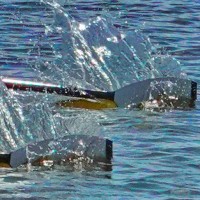Evaluation of Concept2 Comp Sweep Blades

The Concept 2 Comp sculling blades have previously been tested in RBN 2020/11, 2021/10-11 and 2022/06. Recently, we have made our first biomechanical evaluation of the sweep version of the Comps, which have shorter spoon length (43cm) and smaller area compared to the standard Smoothie sweep blades (54cm). Two sets of oars for a coxless four were instrumented and calibrated. The oars had the following inboard / total length:
- Smoothie blades 115 / 374 cm.
- Comp blades with 115 / 375cm;
An elite-level coxless four performed the test, which consisted of 10 x 500m at a racing stroke rate with identical weather conditions across pieces, changing oars in the following sequence, so, each set of oars was used 5 times.
The blade efficiency - defined by its slippage in the water (RBN 2019/12) - was lower in the Comp blades during the whole drive (Fig1, b) and its average value was 2.8% lower, which was expected: at a similar blade force, the smaller area of the Comp blades produces higher water pressure per cm2, therefore higher blade slippage. This lower blade efficiency would cause extra losses of 6.3W (3.35%) of propulsive power, which should result in 1.12% slower rowing speed with Comp blades (-4.3s over 2km). However, rowing speed was practically the same with two blade types, despite lower power production with the Comp blades. How is this possible?
To solve this mystery, we should assume that the Comp blade saves energy someplace else to balance extra slippage losses, so that the overall efficiency of the system was very similar…
…
Concluding, in the current setup, both the Smoothie and Comp sweep blades showed similar overall effectiveness and no evidence for a superior one of the two.
Potentially, effectiveness of Comp blades could be increased with adjustments of rowing technique and rigging in some directions…
…
It is difficult to predict the degree to which the above adjustments should be made - more testing is required. Ideally, all changes should be tested and verified for each specific crew individually, preferably, with biomechanical measurements.
This is a short version of this Newsletter. Full text is available for BioRow members: https://biorow.com/membership/
©2023 Dr. Valery Kleshnev



